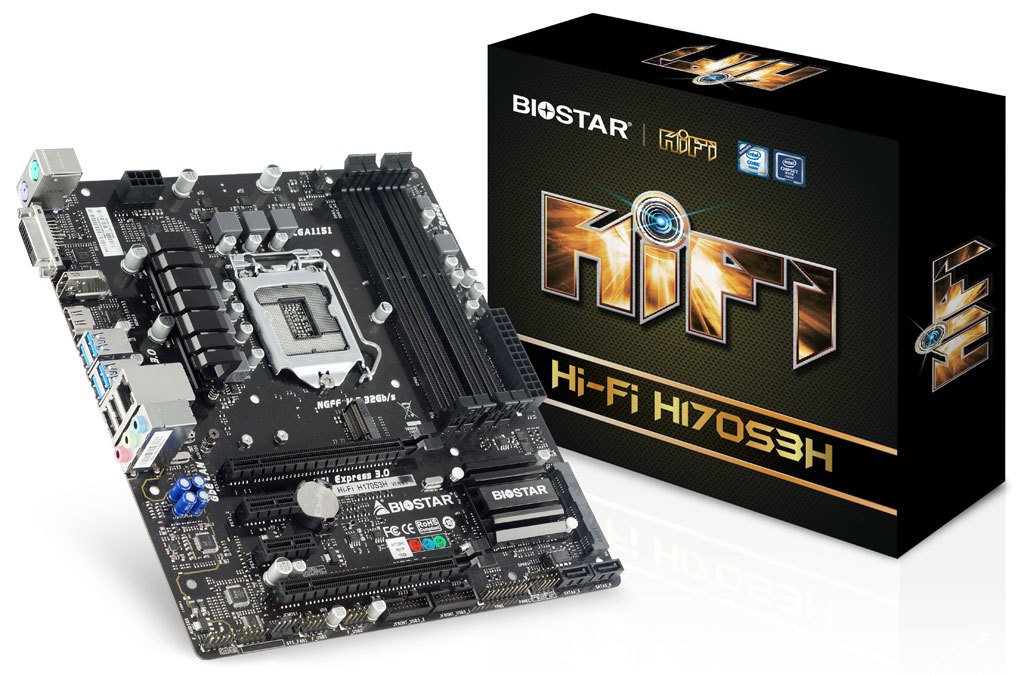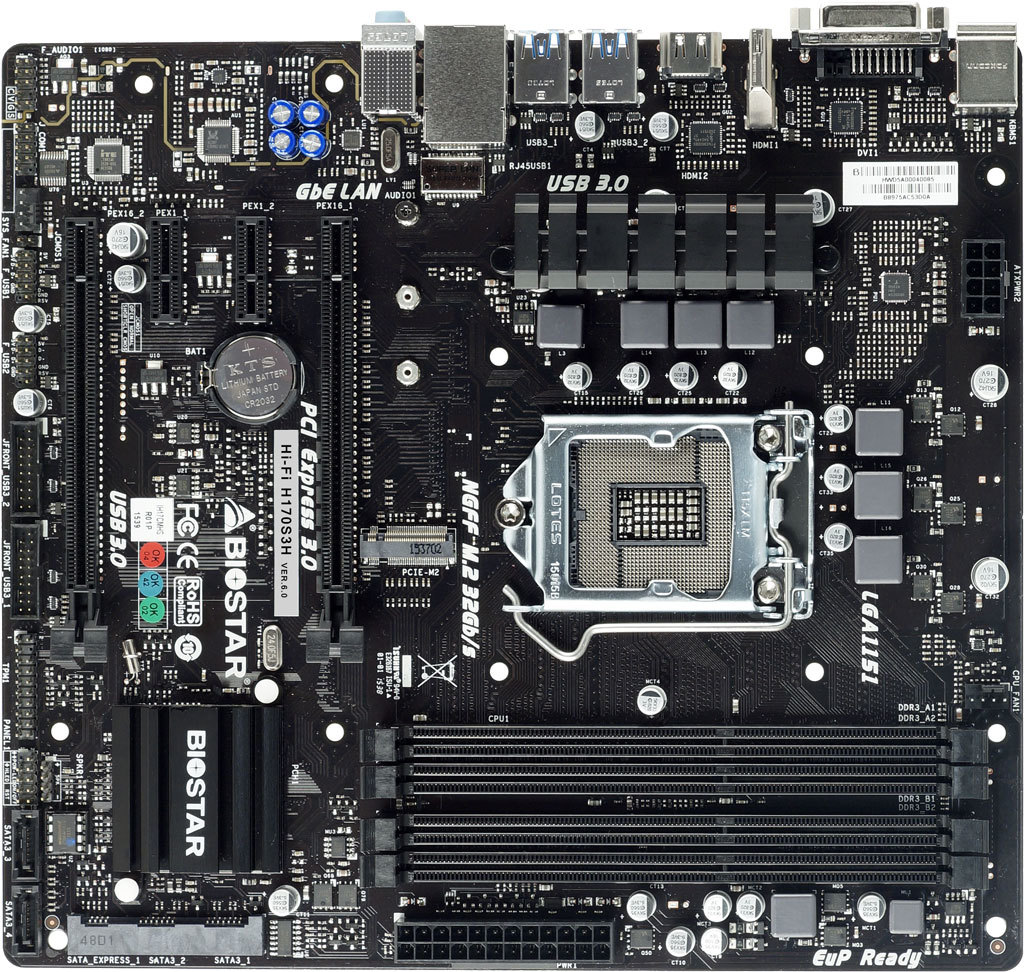Biostar's Hi-Fi H170S3H Shouldn't Be Called Hi-Fi
Biostar announced a new motherboard for the LGA 1151 platform, the Hi-Fi H170S3H. Although this board falls into Biostar's Hi-Fi series of motherboards, you shouldn't expect high-end audio here.
Power Design & Connectivity
The Hi-Fi H170S3H is a microATX motherboard, targeting mid-range budget PC builders. The motherboard has an adequate 7-phase power design with an ISL (Intersil) PWM controller, which shouldn't have any issue handling any of the currently available Skylake processors.
Biostar opted to use four DDR3L DIMM slots instead of the typical DDR4 slots used on Skylake motherboards, which makes the overall system build a little less expensive thanks to the lower price of DDR3L.
The motherboard has a total of four SATA 3 connectors, two of which are set up to be used in a SATA Express configuration. It also features an M.2 Key M connection. There are two PCI-E x16 interfaces; one is fed via the CPU's on-board PCI-E controller, whereas the other uses an x4 PCI-E lane configuration from the H170 chipset. In between the x16 slots are two PCI-E x1 ports.
For USB connectivity, there are four USB 3.0 and two USB 2.0 ports on the back I/O panel, with an additional two USB 3.0 and four USB 2.0 connections available via use of internal headers.
HSIO Lanes
Unlike some high-end motherboards, like the ASRock Fatal1ty Z170 Professional Gaming i7, there shouldn't be any serious connectivity issues on this motherboard with the HSIO lanes. The H170 chipset features a total of 22 HSIO lanes that can be used by the various connectivity devices across the motherboard. Between the PCI-E (6 lanes), USB 3.0 (6 lanes), M.2 (4 lanes), LAN (1 lane) and SATA connections (5 lanes), Biostar has utilized all 22 HSIO lanes, but none of the lanes are shared with other devices.
Hi-Fi Audio (JK)
Overall, the board looks to be well rounded, but it does have one issue: the audio. Biostar lists these motherboards as being Hi-Fi solutions, trying to attract users with the promise of an excellent audio experience. The problem is that Biostar is cutting corners in this area. The audio ALC887 codec is rather old, and although it is still commonly used on motherboards, it isn't what you would expect from a "Hi-Fi" solution.
Get Tom's Hardware's best news and in-depth reviews, straight to your inbox.
Biostar reinforced the codec with four high quality capacitors and segmented the codec from the rest of the motherboard as indicated by the yellow trace line seen in the bottom right-hand corner, but the company doesn't use a shield to cover the audio chipset and further reduce electromagnetic interference.
On a budget motherboard, I typically would still consider this to be a sound and sensible audio solution, which should be better than some competing motherboards (at least by design), but Biostar made two more mistakes with its implementation.
First, it used only three 3.5 mm audio connections and excluded an SPDIF port, limiting users to at best a 4-channel audio solution and microphone. Second, it wrote "Hi-Fi" all over the place to describe a product that is clearly not Hi-Fi, using the term purely for marketing purposes without any real features to back it up.
| Biostar's Hi-Fi H170S3H | |
|---|---|
| Chipset | Intel H170 |
| Form Factor | MicroATX |
| Memory Support | Dual-Channel DDR3L 1600/1333 MHz4 x DDR3L (Up to 32 GB) |
| Expansion Slots | 2 x PCI-E x16 3.0 Slots (x16 + x4)2 x PCI-E x1 3.0 Slots |
| Storage | 4 x SATA 31 x SATA Express1 x M.2 Key M |
| USB | 4 x USB 3.0 Ports2 x USB 3.0 Headers2 x USB 2.0 Ports2 x USB 2.0 Headers |
| LAN | Realtek RTL8111H |
| Codec | Realtek ALC887 |
Although the audio capabilities of the motherboard are being talked up too much and oversold, the board is still quite well rounded and should perform well as a mid-range budget solution. There is currently no word on pricing or availability.
______________________________________________________________________
Michael Justin Allen Sexton (or MJ) is a Contributing Writer for Tom's Hardware. As a tech enthusiast, MJ enjoys studying and writing about all areas of tech, but specializes in the study of chipsets and microprocessors. In his personal life, MJ spends most of his time gaming, practicing martial arts, studying history, and tinkering with electronics.
Follow Michael Justin Allen Sexton @EmperorSunLao. Follow us on Facebook, Google+, RSS, Twitter and YouTube.
-
gamebrigada Those HDMI ports aggravate me.... There is clearly enough room to put them side by side, possibly would have to move some other stuff, also they could just be stacked...Reply
Even if they were simply trying to save room, they could have had them both upright...
Its not a big deal, but someone breaking one of those ports, or someone trying to plug in an HDMI cable into one of the ports while the computer is under a desk where you can't stick your head in. Both of those people will curse you as a company... -
Achoo22 I challenge the author to demonstrate, scientifically, that the included audio solution does not render audio in high fidelity. Being limited to /four/ speakers hardly disqualifies the setup and omitting garbage from Creative Labs and co absolutely doesn't disqualify the system.Reply -
IInuyasha74 Reply16947564 said:I challenge the author to demonstrate, scientifically, that the included audio solution does not render audio in high fidelity. Being limited to /four/ speakers hardly disqualifies the setup and omitting garbage from Creative Labs and co absolutely doesn't disqualify the system.
Alright, well I don't have one of these boards to test hands-on, but how is this for sufficient evidence?
http://www.tomshardware.com/reviews/high-end-pc-audio,3733.html
When Tom's Hardware tested out the higher-quality ALC889 it was clearly noted as being "Near Hi-Fi" and lacking in certain areas. If the ALC889 didn't qualify as Hi-Fi, then the lower-end ALC887 certainly isn't going to either.
Looking past that, what do you expect out of a Hi-Fi audio solution? Most would expect a baseline of features to go hand-in-hand with the audio codec. Being able to actually connect to a high-end speaker system over SPDIF and being able to connect enough speakers for a 5.1 or 7.1 surround sound experience are going to matter to users. That doesn't mean that the audio setup on this board is bad, but coming out and professing it as Hi-Fi to try and attract users looking for a motherboard with high-quality audio features, and then giving them an out-dated codec and extremely limited audio features shouldn't be done.
More importantly, it is the responsibility of the writers who work for this site to cut out the marketing speak and tell our readers what are real features present on a product and what aren't. To not call out this issue would be irresponsible of me. -
TunaSoda I don't agree that a MB should have audio or video output at all, but that's just me...Reply -
rwinches Tut Tut..Reply
Just a mere misunderstanding when we say Hi-Fi we mean 'High-Five' of course. -
photonboy HDMI port:Reply
To "gamebrigada" there is one HDMI port, and one DP port.
I'm guessing they made one 90-deg to the other intentionally to help differentiate the two so it would actually be EASIER if you can't see what you are doing. -
therealduckofdeath Hi-Fi has nothing to do with the number of outputs. Hi-Fi I'd a very limited specification which every sound chip is capable of. It's basically a frequency range requirement made up in the 60s or 70s. And really only is relevant for analogue systems.Reply
The complaints in this article are as silly as the label on the motherboard. :) -
crisan_tiberiu And yes, i love those useless PS2 ports on every motherboard. I bet they could use that space more eficiently.Reply




